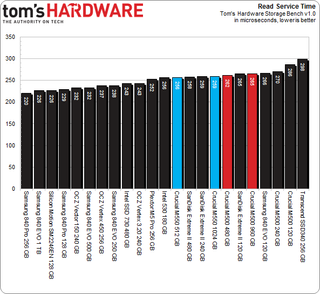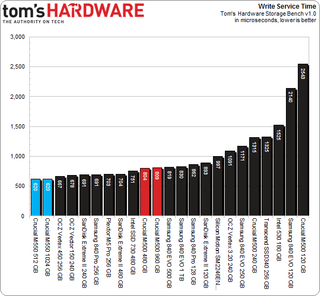The Crucial M550 SSD Review: Striking Back With More Performance
Crucial's M500 brought mainstream performance, enhanced features, and rock-bottom pricing together in one of the most-recommended SSDs of 2013. Following up, Crucial has a refined version called the M550, juiced-up for performance-hungry enthusiasts.
Results: Tom's Storage Bench v 1.0, Continued
Service Times
Beyond the average data rate reported on the previous page, there's even more information we can collect from Tom's Hardware's Storage Bench. For instance, mean (average) service times show what responsiveness is like on an average I/O during the trace.
It would be difficult to graph the 10+ million I/Os that make up our test, so looking at the average time to service an I/O makes more sense. For a more nuanced idea of what's transpiring during the trace, we plot mean service times for reads against writes. That way, drives with better latency show up closer to the origin; lower numbers are better.
Write latency is simply the total time it takes an input or output operation to be issued by the host operating system, travel to the storage subsystem, commit to the storage device, and have the drive acknowledge the operation. Read latency is similar. The operating system asks the storage device for data stored in a certain location, the SSD reads that information, and then it's sent to the host. Modern computers are fast and SSDs are zippy, but there's still a significant amount of latency involved in a storage transaction.

Only SanDisk's A110 PCIe M.2 can boast better write service times, and no SSD is significantly better when it comes to mean read service times.
Isolating the range of M500s and M550s, Crucial's drives span the entire width and breadth of this chart's scale. The 120 GB M500 is off on its own, while the larger M500s get crammed somewhere in the middle. Both M550s end up in favorable real estate; south and west is where you want to be.

The M550s end up in the middle of this chart. The differences between our tested drives aren't enormous, though they do add up. Fortunately, the M550s beat Crucial's 480 and 960 GB M500.

Just look at the M550s go! The top two spots are a tie; the 512 and 1024 GB models are only rivaled by each other.
Stay on the Cutting Edge
Join the experts who read Tom's Hardware for the inside track on enthusiast PC tech news — and have for over 25 years. We'll send breaking news and in-depth reviews of CPUs, GPUs, AI, maker hardware and more straight to your inbox.
Our mean write service chart shows a greater range than the read chart did. The same observation can be made about the read-versus-write comparison at the top of this page. Vertically, it stretches on and on, reflecting a massive spread in write times.
The slowest drive is the 120 GB M500, with a mean service time of 2543 microseconds. At the other end, Crucial's M550s both report incredible 620-microsecond write service times. That means the 120 GB M500 takes four times longer, on average, to service each write operation in our trace. In reality, that's not such a noticeable wait. But the small M500 sure isn't winning any popularity contests. Micron knows this. As mentioned previously, the 128 GB M550 uses twice as many dies to improve parallelism. We expect it to rival a number of 256 GB competitors as a result.
Current page: Results: Tom's Storage Bench v 1.0, Continued
Prev Page Results: Tom's Storage Bench v 1.0 Next Page Results: PCMark 7 And PCMark Vantage-
ikyung Heard rumors of Samsung planning to market the 850 with aggressive pricing this year. Would like to see Crucial and Samsung duke it out in pricing.Reply -
cryan ReplyHeard rumors of Samsung planning to market the 850 with aggressive pricing this year. Would like to see Crucial and Samsung duke it out in pricing.
They already have IMHO. The Samsung 840 EVO is significantly cheaper than it was at launch. It and the M500 have seemed to move in lockstep. Along the way, we've seen other manufacturers follow suit. Even Intel's 530 series, which has been on the more expensive side of mainstream products has been seen for just $140 for the 240 GB version here in the State.Regards,Christopher Ryan -
venk90 INSANELY GOOD DEAL ON AMAZON ! The 512 GB SSD is listed at 169$ incorrectly ! Grab them before they change it. I ordered 20 myself ! Will e-bay all of it or feel bad and return it to Amazon !Reply -
cryan ReplyI just splashed $250 (delivered to Oz) on a M500 480GB mSATA, eh, can't complain.
I hope Crucial continues to sell the M500 right where it is. The deals are just too good, and it'd be truly sad were Crucial/Micron to up the price on us.And they're not slow. I know it seems like they're sub par compared to some of the last few drives we've tested, but the reality is most users are never going to notice the speeds between different SSD models. The only exception is jumping from an older SATA II drive to a modern SATA III SSD. Even then, you'd need solid hardware in the system.Regards,Christopher Ryan -
Ankursh287 M500 available at $240 (amazon)..damn good drive for the price, performance difference between M500 , M550 & 840/840 pro won't visible to normal user.Reply -
Nada190 When I look at SSD's I want price to performance because I won't even notice a difference.Reply -
Drejeck Specifically for gaming which would be the best? All sort of tricks are allowed, from tweaks to samsung's magician (ram caching).Reply -
RedJaron ReplyOf course, we're in the throes of post-launch pricing. In a few weeks, it's possible that the gap between M500 and M500 will narrow.
Typo on the last page. One of those should be 550.
Happy to see Crucial with this update. I'm with a lot of people, you don't see a difference in SSD performance outside benchmarks. Give me something reasonably fast with great durability and I'm sold. With all this talk of the maturing of 20nm manufacturing, I'd love to see an M500 V2 with less overprovisioning.
-
gizmoguru Hay Tom's the chart for Sequential Reads Benchmark is labled "Random Writes", please correctReply
Most Popular

